Panicle blight (flower dieback)
By Dr Elizabeth Dann, Akila Prabhakaran, Kaylene Bransgrove
Read the January 2021 update to this article here.
Severe panicle blight, or inflorescence dieback, occurred in blocks in the Bundaberg/Childers growing region during the 2019 flowering. This dieback of inflorescences has been observed in previous years, but was apparently much more severe in 2019. There was no fruit harvested from some of the worst affected blocks, and yields in other blocks were greatly reduced.

What is it? What does it look like?

The photos show the typical symptoms of panicle blight. The flower shoot is sometimes wilted, and flowers turn brown and necrotic with the dieback clearly extending down the panicle (Figures 1-3). The vegetative shoots of indeterminate inflorescences also wilt and die. The dieback is often arrested at the node (Figure 2), but occasionally extends further down the branch.
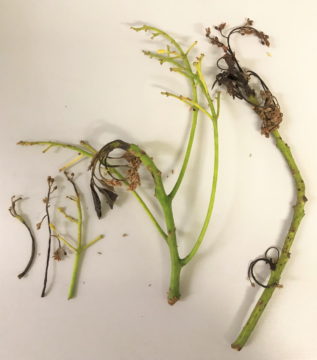
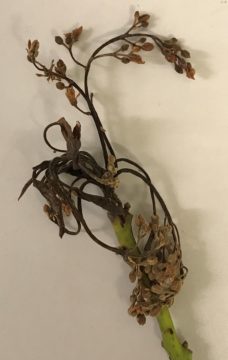
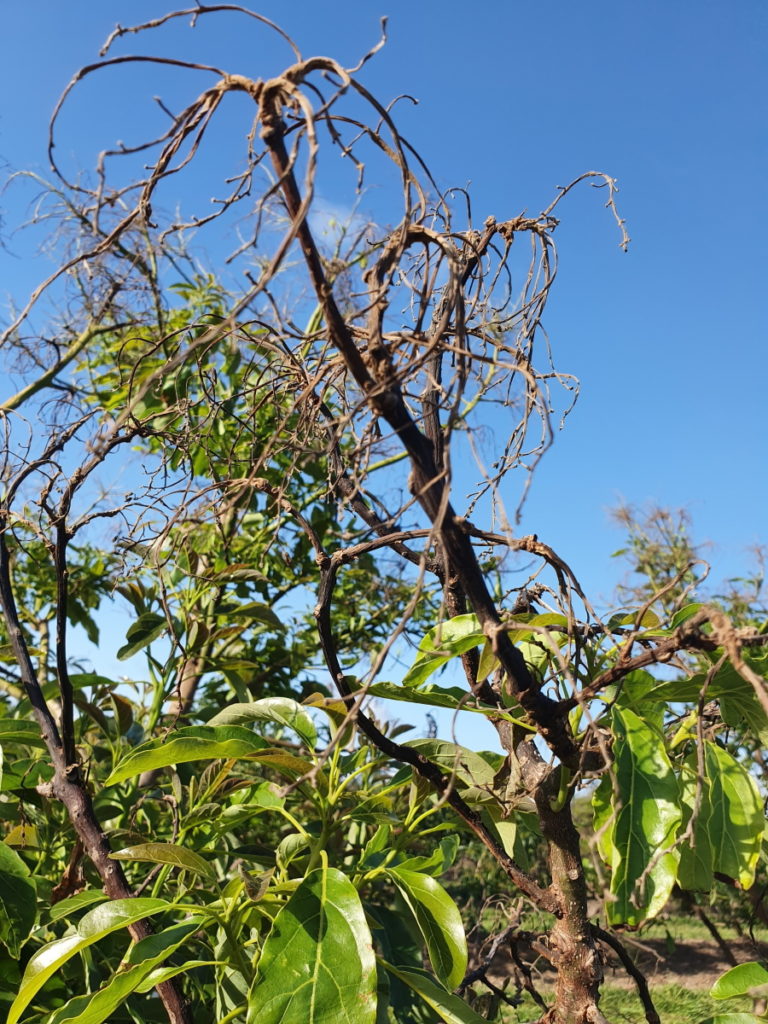

The skeleton of the inflorescence remains in the canopy until it is pruned out (Figures 4 and 5).
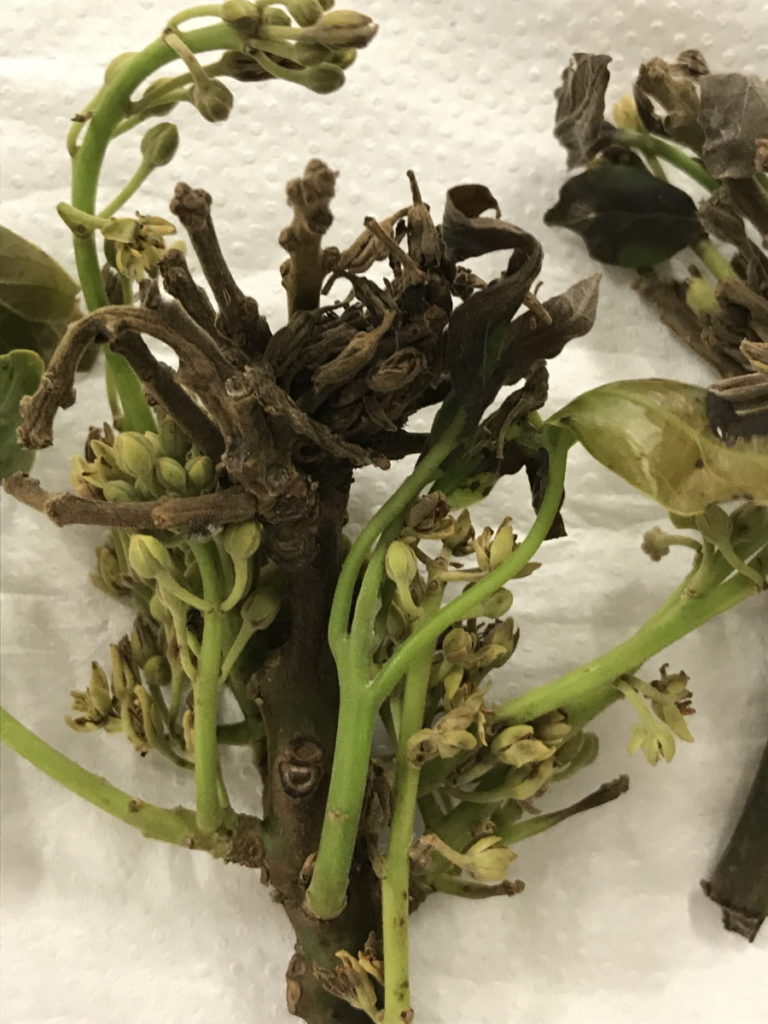
When dieback occurs in the early stages of flowering, inflorescence elongation is prevented and a “witches broom” type symptom is observed (Figure 6).
Shoot blight affecting newly planted trees (Figures 7 and 8) was also common in the region last year.
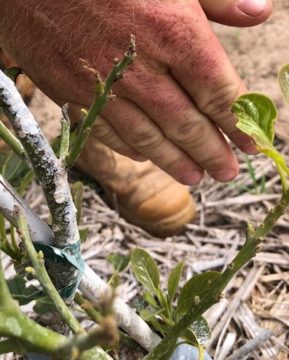
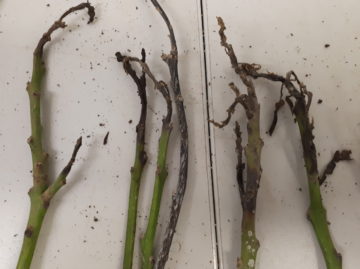
Is it new?
No, we don’t think it is due to some new or exotic pathogen that would be of biosecurity concern. It has been seen in previous years, and we also saw it in orchards in New South Wales, Western Australia and New Zealand, so there is probably some degree of panicle blight in most, maybe all, orchards across all growing regions.
What causes it?
We’d be very happy to hear your ideas on the cause, if you are familiar with it in your orchards!
Anecdotal evidence from colleagues in other countries (Israel, California, South Africa) say it is caused by “Dothiorella”, (the old name for fungi in the Botryosphaeriaceae family, which also cause stem end rot), and associated with tree stress, eg drought. There are similar problems in other crops such as macadamia, pistachio, mango and lychee.
We collected several samples ourselves from the field, and growers and agronomists also sent us symptomatic tissues. We carefully selected tissues, surface-sterilised to remove any microbes which colonised decaying tissue (secondary colonisers), and plated small pieces of tissue onto selective media in Petri dishes.
We monitored growth of fungi and identified several genera. These included Alternaria, Cladosporium, Colletotrichum, Fusarium, Pestalotiopsis, Diaporthe, Botryosphaeria (eg “Dothiorella”). The fungi we have isolated are the “usual suspects”, that is, those commonly associated with avocado fruit stem-end rot, and those reported to cause similar flower dieback symptoms in macadamia, pistachio, mango and lychee.
There is no doubt that conditions leading into the 2019 flowering in Central Queensland were challenging, despite orchard irrigation. A couple of years of drought, poor quality irrigation water (chloride levels in excess of 80mg/L), and low rainfall totals in July (9.6mm), August (14.2mm) and September (3.8mm), most likely exacerbated the problem. (You can read more about acceptable soil chloride levels for avocados on page 17 of the Winter 2018 edition of Talking Avocados – PDF here, a catalogue of our back issues here.)
What are we doing about it?
We have included additional research activity in Improving avocado orchard productivity through disease management (AV16007) to investigate the issue.
- We will continue to receive samples from 2020 flowering to build our database of distribution and associated fungi.
- Pathogenicity testing in the glasshouse involves spraying fungi onto flowers and attempting to replicate the dieback symptoms in order to demonstrate conclusively that a particular fungus causes the disease. More than one fungus may be involved.
- We have communicated with the major agrichemical companies and have screened several conventional fungicides and “biofungicides” not currently registered in avocado, for their ability to inhibit growth of selected fungi. This was done in the laboratory, and involved some 2000+ Petri dishes.
- From these in vitro tests, four fungicides were selected for trialling in the field. Two trials have been established in Hass orchards at Childers and Bundaberg, and first sprays have been applied during early flowering. There will be a second spray at about mid-bloom, followed by standard copper program. The new treatments will likely be applied again later in the season when conditions have been conducive to infection of fruit (rainy periods).
- We will be assessing the trees in the field trial for crop safety (phytotoxicity), panicle blight incidence and severity, fruit set/retention, final yield and post-harvest anthracnose and stem-end rot.
What can you do about it?
If you see it, please send some pictures in an email (e.dann@uq.edu.au), and we may ask you to send us some samples. Early infection stages, when there is still some green/healthy tissue in the inflorescence, is best, not the later skeletal stage.
We would like to know how widely distributed it is, and do further isolations onto selective media to see what fungi or other microbes may be associated. Your information will be treated as confidential and we will not identify blocks or orchards unless you give us permission.
As for management strategy, it is safest to prune out the branches with the dieback. This removes the source of inoculum, assuming that fungi are involved. The fungi can survive on dead branches, skeletal panicles and mummified fruit within the canopy and produce spores which can then spread to flowers and developing fruit in rainy weather, initiating new infections. Maintain optimum tree health at all times by good agronomic and Phytophthora root rot management.
Acknowledgement
The Improving avocado orchard productivity through disease management (AV16007) project is funded by Hort Innovation, using the avocado research and development levy, and contributions from the Australian Government.

This article was produced for the Guacamole of 18 September 2020 and the Spring 2020 edition of Talking Avocados.
Date Published: 17/09/2020